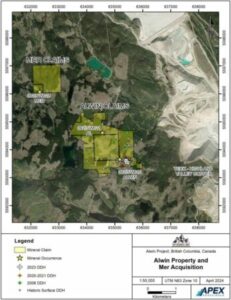Toronto, Ontario – October 12, 2023 – PJX Resources Inc. (“PJX” or “the Company”) is pleased to announce the discovery of massive and semi-massive sulphide boulders of Sullivan deposit style zinc, lead, silver, cadmium, and indium mineralization. This significant new sediment-hosted discovery is on the Company’s Dewdney Trail Property in the Sullivan Minng District in southeastern British Columbia, Canada.
PJX’s prospecting team discovered boulders with sulphide mineralization in an area about 50 metres (m) by 150 m at the base of a talus slope. Ten samples have been analyzed with grades shown in the table below.

Some sulphide boulders display layering and breccia textures with grades of zinc-lead-silver mineralization similar to ore at the Sullivan deposit (see photos below).
Dave Pighin, PJX Resources’ consulting geologist comments: “In my 60 years of exploring for Cominco and others in the Sullivan Mining District, this is the first time that this style of mineralization with such good grades have been discovered outside the Sullivan Mine basin that is located about 25 km to the west.”
The sulphide boulders with zinc (sphalerite mineral), lead (galena), and iron (pyrite and pyrrhotite) are magnetic. The boulders occur at the base of the mountain slope and on the edge of a large magnetic anomaly identified by Expert Geophysics from the 875 line-kilometre airborne geophysical survey flown for PJX in 2021 (see map below).
John Keating, President of PJX commented: “The discovery of these boulders with this style of mineralization and grades similar to ore at the Sullivan may be the most compelling evidence in 130 years since the Sullivan deposit was discovered of a potential second Sullivan type deposit. Our geological, geochemical, and geophysical work on the Dewdney Trail Property support the potential to discover a significant deposit.”
“We would like to thank the Kennedy family of prospectors and our geologists for their great work. Boots on the ground and breaking rocks resulted in this new discovery. We are continuing to prospect and map the area to identify additional boulders of mineralization and to locate bedrock sources of the mineralization. Additional information will be announced as it becomes available.”
Sample SMT-23-1 (6.71% zinc, 2.23% lead, 16.05 g/t silver, 1258.9 ppm or 0.12% copper)

Sphalerite (zinc sulphide), galena (lead sulphide), and iron sulphides (pyrite, pyrrhotite) occur in fragments that are locally banded or bedded in apearance as seen above. The mineralization also occurs in the groundmass of the rock.
Sample SMT-23-8 (3.55% zinc, 0.98% lead, 7.5 g/t silver, 442.1 ppm or 0.04% copper)

Although this sample is lower in grade it tells an important story. The individual massive sphalerite fragments are a possible indicator of higher grade zinc rich massive sulphides possibly buried under the talus slope.
Sample SMT-23-7 (9.33% zinc, 2.48% lead, 14.62 g/t silver, 495 ppm or 0.04% copper)

Alternating dark and light coloured bands with sulphides (zinc, lead, iron) appear to be sulphide-rich beds that have been broken apart possibly by slumping during deposition on the ocean floor, or the beds may have broken apart during later folding.
Airborne Magnetic Map

Massive sulphide boulders occur downslope from a magnetic anomaly (red to pink area). The boulders are magnetic. The initial target area with deposit potential is defined by an elevated magnetic signature that is over 1.5 km along strike. Stronger magnetic anomalies (pink colour) may represent more iron rich (pyrrhotite mineral) zones similar to those that occur at the Sullivan deposit. Less strong magnetic anomalies (red to orange colour) may represent areas with more zinc or lead sulphide mineralization that would be more weakly magnetic.
The 160 million tonne Sullivan deposit produced ore containing some 17 million tonnes of zinc and lead metal and more than 285 million ounces of silver during 90 years of operation before closing in 2001.
Qualified Persons
The geological disclosure and content of this news release has been reviewed and approved by Dave Pighin, P.Geo., and John Keating P.Geo. (qualified persons for the purpose of National Instrument 43-101 Standards of Disclosure for Mineral Projects). Mr. Pighin is a consulting geologist for PJX on base metal targets. Mr. Keating is the President, Chief Executive Officer and a Director of PJX.
Technical information for the Dewdney Trail exploration program is obtained and reported under a formal quality assurance and quality control (“QA/QC”) program. The samples were cut with a diamond saw under the direction of qualified geologists. Samples were then labeled, placed in plastic bags, sealed and with sample numbers recorded. Samples were delivered by the Company to MSALabs in Langley, British Columbia. Blanks, standards and duplicates were done in accordance with industry standards. Analyses, including overlimits, were performed in accordance with MSAlabs’ analytical methods reported in the table.
About PJX Resources Inc.
PJX is a mineral exploration company focused on building shareholder value and community opportunity through the exploration and development of mineral resources with a focus on gold, silver and base metals (zinc, lead, copper, nickel). PJX’s properties are located in the historical Sullivan Mine District and Vulcan Gold Belt near Cranbrook and Kimberley, British Columbia.
Please refer to our web site http://www.pjxresources.com for additional information.
FOR ADDITIONAL INFORMATION PLEASE CONTACT:
Linda Brennan, Chief Financial Officer (416) 799-9205 info@pjxresources.com













